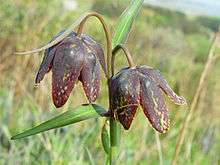Fritillaria affinis
| Chocolate lily | |
|---|---|
 | |
| Fritillaria affinis | |
| Scientific classification | |
| Kingdom: | Plantae |
| (unranked): | Angiosperms |
| (unranked): | Monocots |
| Order: | Liliales |
| Family: | Liliaceae |
| Genus: | Fritillaria |
| Species: | F. affinis |
| Binomial name | |
| Fritillaria affinis (Schult. & Schult.f.) Sealy | |
| Synonyms[1] | |
| |
Fritillaria affinis (checker lily, chocolate lily) is a highly variable species in the genus Fritillaria, native to western North America, in California, Klamath Ranges, the north coast ranges, Cascade Ranges, north Sierra Nevada foothills, and the San Francisco Bay Area, north to British Columbia, Oregon, Washington, Montana and Idaho. [2]
It grows from a bulb, which resembles a small mass of rice grains. The stems are 10–120 cm tall. The flowers are produced in the spring, nodding, 1–4 cm, yellowish or greenish brown with a lot of yellow mottling to purplish black with little mottling, or yellow-green mottled with purple. The leaves are in whorls.[3]
Its habitat includes oak or pine scrub or open woods and thickets near the coast.
There are two varieties:
- Fritillaria affinis var. affinis
- Fritillaria affinis var. tristulis
Cultivation and uses
Prefers low to mid-elevation, shade or part shade, dry summer dormancy, good drainage. Some sources say that it may be difficult to cultivate, but other sources say that it is one of the easiest fritillaries to grow. The roots or bulbs cooked make palatable and nutritious food.
References
- ↑ Kew World Checklist of Selected Plant Families, synonyms for Fritillaria affinis var. affinis
- ↑ Kew World Checklist of Selected Plant Families, Fritillaria affinis
- ↑ Flora of North America Editorial Committee, e. 2002. Magnoliophyta: Liliidae: Liliales and Orchidales. Flora of North America 26: i–xxvi, 1–723.
External links
![]() Media related to Fritillaria affinis at Wikimedia Commons
Media related to Fritillaria affinis at Wikimedia Commons
- Treatment from the Jepson Manual
- Harlow, Nora, Jakob, Kristin, and Raiche, Roger (2003) Wild Lilies, Irises, and Grasses. University of California Press. ISBN 0-520-23849-4.
- CalFlora Taxon Report